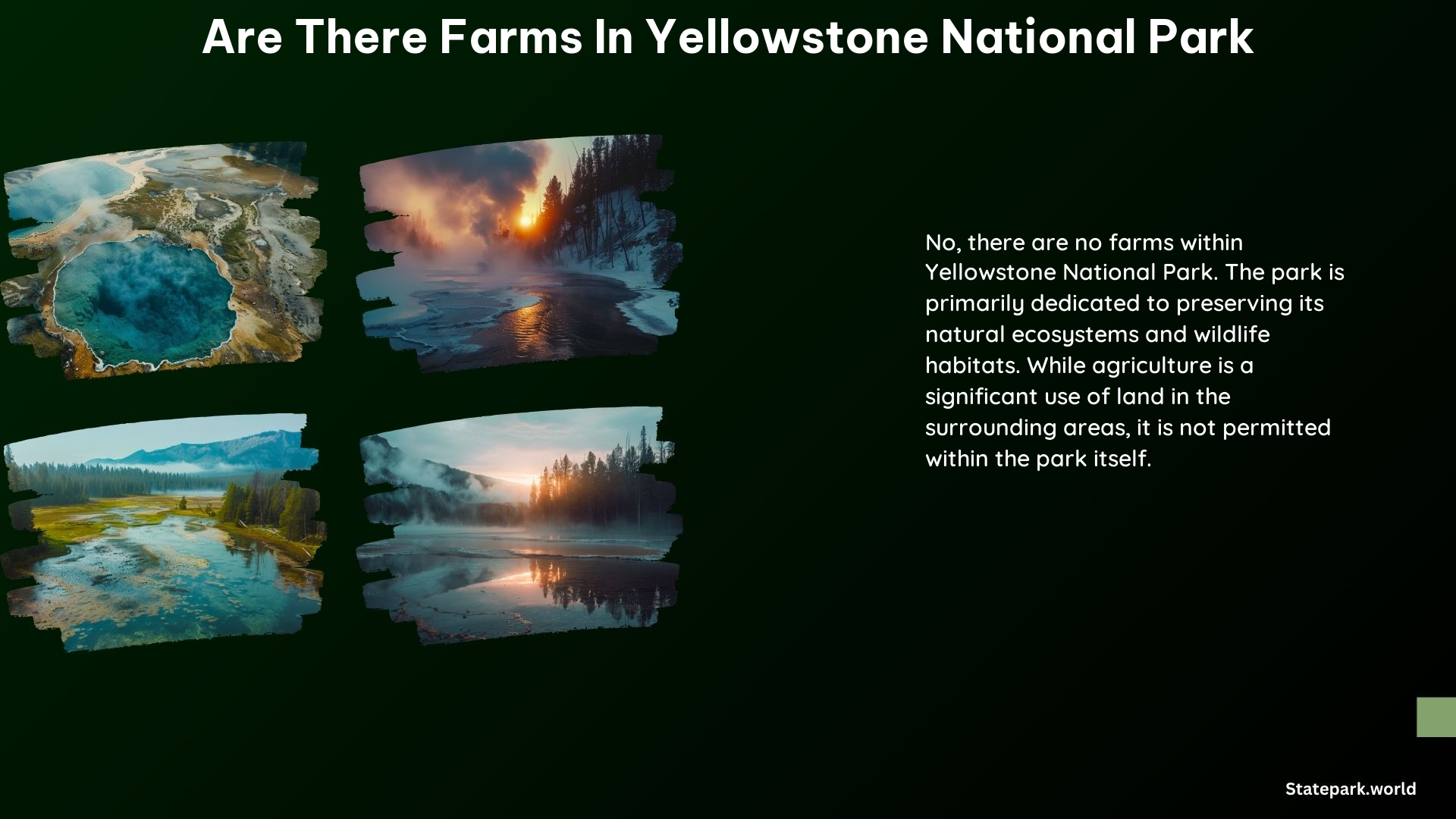No, there are no farms inside Yellowstone National Park. The park is primarily dedicated to preserving its natural resources and wildlife, and farming activities are not allowed within its boundaries. However, there are private working lands and agricultural areas outside the park that play a crucial role in maintaining the ecosystem and biodiversity of the Greater Yellowstone Ecosystem.
No Farms Inside the Park
Yellowstone National Park is the first and oldest national park in the United States, established in 1872. The park covers an area of over 3,472 square miles (8,983 square kilometers) and is known for its diverse and unique natural features, including geothermal hot springs, geysers, and abundant wildlife.
One of the primary goals of Yellowstone National Park is to preserve the natural landscape and ecosystem. As such, farming activities are strictly prohibited within the park’s boundaries. The park is managed by the National Park Service, which is responsible for protecting the park’s natural resources and ensuring that visitors can enjoy the park’s wonders without disrupting the delicate balance of the ecosystem.
Private Working Lands Outside the Park

While there are no farms within Yellowstone National Park, the Greater Yellowstone Ecosystem, which includes the park and the surrounding areas, is home to a significant amount of private working lands. These lands, which make up about 30% of the ecosystem, or approximately 6 million acres, play a crucial role in maintaining the overall health and biodiversity of the region.
The private working lands in the Greater Yellowstone Ecosystem include a variety of agricultural activities, such as livestock grazing, hay production, and crop cultivation. These lands provide important habitats for various species of wildlife, including large predators like grizzly bears and wolves, as well as smaller animals and plants.
Agriculture Outside the Park
The counties surrounding Yellowstone National Park are home to a significant amount of agricultural activity. In 2007, the percentage of agricultural crop land in these counties ranged from less than 5% to more than 50%. However, the percentage of land used for agriculture has declined slightly since the 1990s, as development and other land uses have increased.
Despite this decline, agriculture remains an important part of the local economy and plays a crucial role in supporting the overall ecosystem of the Greater Yellowstone Ecosystem. Farmers and ranchers in the region work to balance their agricultural activities with the need to protect the natural resources and wildlife that are so important to the region.
Importance of Private Lands
The private working lands outside of Yellowstone National Park are essential for maintaining the overall health and biodiversity of the Greater Yellowstone Ecosystem. These lands provide important habitats for a wide range of species, including large predators like grizzly bears and wolves, as well as smaller animals and plants.
In addition, the private working lands help to support the local economy and provide important resources, such as food and fiber, to the surrounding communities. By working with landowners and supporting sustainable agricultural practices, the National Park Service and other conservation organizations can help to ensure that the Greater Yellowstone Ecosystem remains healthy and thriving for generations to come.
Farm Near the Park
While there are no farms within the boundaries of Yellowstone National Park, there are some farms and agricultural operations located near the park. One example is Bodhi Farms, which is located about 79 miles from the west entrance of the park and the town of West Yellowstone.
Bodhi Farms is a working farm that offers a variety of agricultural experiences for visitors, including tours, farm-to-table dining, and opportunities to interact with the animals and learn about sustainable farming practices. While the farm is not located within the park itself, it can serve as a base for visitors who are planning to explore Yellowstone National Park and the surrounding region.
Overall, while there are no farms within the boundaries of Yellowstone National Park, the Greater Yellowstone Ecosystem is home to a significant amount of private working lands and agricultural activity that play a crucial role in maintaining the overall health and biodiversity of the region.
References:
- https://www.tripadvisor.ie/ShowTopic-g60999-i481-k2100515-Game_farm_NOT-Yellowstone_National_Park_Wyoming.html
- https://westernlandowners.org/the-importance-of-private-working-lands-to-yellowstone-in-the-twenty-first-century/
- https://www.bodhi-farms.com/yellowstone-national-park-summer
- https://www.nps.gov/yell/learn/nature/land-use.htm
- https://en.wikipedia.org/wiki/Yellowstone_National_Park
